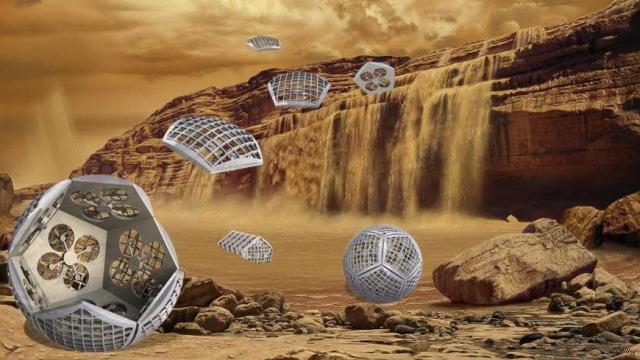Why send one robot to explore a world when you can send a whole bunch all at once? Such is the thinking behind NASA’s highly conceptual Shapeshifter — a modular, morphing, self-assembling robot capable of deploying several smaller machines.
The Shapeshifter concept is currently being developed as part of NASA’s Innovative Advanced Concepts (NIAC) program, which encourages researchers to devise creative new ways of exploring distant words. The morphing bot is being designed and built at NASA’s Jet Propulsion Lab by roboticist Ali Agha and his collaborators from Stanford University and Cornell University, according to a NASA JPL press release.
This aerial amphibious robot is still in its embryonic stage of development, but should the concept prove feasible, the machine could be used to explore the dynamic environment on Saturn’s moon Titan, the only object in the Solar System other than Earth to host a liquid at the surface — even if it is mucky, oil-like liquid methane.
So far, the early tests of Shapeshifter look to be promising. Currently, the 3D-printed prototype can move by rolling around on the ground, but it can also split itself in half, with the upper portion taking flight in the form of an aerial drone.
Agha and his colleagues say this is only the beginning. Eventually they’ll equip the bot with components capable of swimming, floating and navigating through caves, among other possibilities.
Indeed, such a contraption would be perfect for Titan, with its sprawling methane seas, flowing rivers and complex topography. Titan, in addition to hosting cave systems, could also contain icy volcanoes that erupt ammonia or water, according to NASA. Having a bot explore these features would be pretty incredible, to say the least.
“We have very limited information about the composition of the surface. Rocky terrain, methane lakes, cryovolcanoes — we potentially have all of these, but we don’t know for certain,” said Agha in the NASA release. “So we thought about how to create a system that is versatile and capable of traversing different types of terrain but also compact enough to launch on a rocket.”
In its idealised final form, Shapeshifter would be a morphing, modular, self-assembling robot comprised of smaller robots dubbed “cobots”. Every cobot would be equipped with a small propeller, allowing them to move independently of one another.
The cobots “could also go spelunking, forming a daisy chain to maintain contact with the surface,” according to NASA. “Or they could transform into a sphere to roll on flat surfaces and conserve energy.”
Once on Titan’s surface, the landing portion of the system, or “mothercraft”, in the words of Agha, would provide an energy source for its cobot army. The lander would also be equipped with various scientific instruments and tools.
The team estimates that 10 cobots would fit within a lander measuring about 3m wide — around the size of the Huygens lander, which visited Titan back in 2005. But unlike other landers, this one would be able to fly through the moon’s dense atmosphere.
In its current form, Shapeshifter is semi-autonomous, requiring some human guidance. Eventually the bot will be fully self-reliant, which it’s going to have to be given the complexities of exploring Titan, not to mention all its moving parts.
Having mission controllers fully operate the system from Earth would be super awkward, given that it takes over 70 minutes for signals to reach Titan.
[referenced url=”https://gizmodo.com.au/2019/07/will-nasa-find-life-on-titan/” thumb=”https://gizmodo.com.au/wp-content/uploads/2019/07/nasa-410×231.jpg” title=”Will NASA Find Life On Titan?” excerpt=”Have you ever wondered why NASA is sending a spacecraft to one of Saturn’s moons and what it might find there? This beautiful comic may help.”]
There’s obviously still a lot of work to be done, and Shapeshifter is far from ready. Thankfully we still have NASA’s Dragonfly to look forward to. The rotorcraft lander is scheduled to launch in 2026 and arrive at Titan around 2034.
